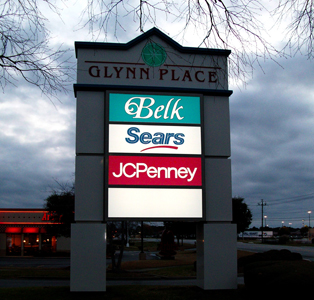So you have a set of channel letters that need to be updated from neon to LED—either by the desire of the sign’s owner or your ability to find new income streams. Let’s take a look at some of your considerations!
Letter Heights
Letter heights typically determine the module footprint. Today most LED suppliers offer two, three, and even more channel letter modules (CLM) per foot, and the reason to use one over the other typically comes down to the above criteria.
The larger the letter, the larger the CLM you can use. This makes the install easier, since you work with less CLM. In return, less labor is involved.
On the other hand, smaller letters or letters featuring serifs and cursive-type fonts typically require smaller footprint modules (like three or more per foot) to fill in and around the tighter letter bends.
Letter Return Depths
Return depths also have a direct effect on the CLM placement.
Typically four-inch (or less) return depths require the CLM to be mounted closer to each other, which technically increases the power consumption and CLM count.
Even shallower return depths require even tighter spacing and possibly a wider beam angle to help prevent hot spots with the point of light so close to the face.
In all cases, consult your particular vendor of choice.
Letter Strokes
As it was with neon, the letter stroke is another vital consideration.
A CLM from any vendor has recommended row spacing for various strokes, and up to five to six inches is standard per row of multiple LED. Thus a large letter with a fifteen-inch letter stroke, as an example, will typically need three or more rows of CLM.
Also some fonts are thick and thin, requiring more rows in the larger areas and less in the serifs or radiuses.
As mentioned previously, your LED vendor should be able to do this recommended layout for you.
Face Color
This factor should be considered if the face of the channel letter is going to stay the same. Face color, as with neon of the past, can be affected by the color of illumination.
For example, red faces with white LEDs offer less saturated “red” color, as the white light washes out through the red face. On the other hand, red LED behind a red face provides for a saturated red with more impact.
However in today’s market, we are seeing less use of all colored LED, as the performance and costs of white LED have increased and the price reduced. It is my belief, though, that placing colored LED behind colored faces gives the best color saturation.
Relative to face color, you also need to consider that white LED is typically available in 3K, 5K, 6.5K, and the newer, more popular 7.2 to 7.5K whites.
Warm K temps (lower numbers) are more yellowish, and high K temps (higher numbers) have a bluer look. Thus a warmer K temp CLM will make, as an example, a red face look better, and a higher K temp CLM with a blue face will make the blue look better.
So you, as the manufacturer of the sign, have choices to further satisfy your customer with your knowledge and to choose the solution that makes them look best.

Halo Mounting
For halo illumination (where a typical letter is stud-mounted off the wall), the wall surface can have a positive or negative effect on the finished look.
For example, halo letters mounted on a nice, polished marble surface will give a direct image of the back of the letter on the shiny surface, and this needs to be addressed.
For this scenario, I recommend using a white pigmented back panel. This ensures that the mirror image is a clean letter shape.
However a word of caution using LED (as they are a point source): If you are using a clear back on this mirrored mounting surface, test a finished letter first. The right solution here can make or break the final look.
By Fritz Meyne, Jr., vice president of Sales at LED lighting solutions provider Bitro Group, Inc.
Photos (top to bottom): Gemini, Bitro Group.











